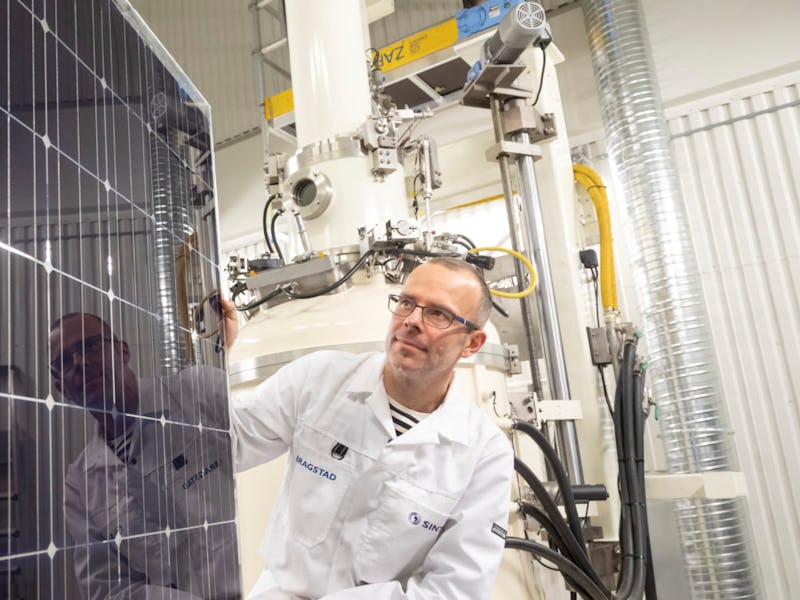Solar Energy: These Heat-Storing Panels Cool the Cells to Boost Output
SINTEF has developed a new kind of panel.

Scientists are looking at cooling solar cells to harvest more energy from the burning sun. Researchers at the SINTEF research organization in Trondheim, Norway, are integrating a tube system into panels that heats water, reducing the heat on the panels while also creating a heat water byproduct.
“The concept involves a modular construction that makes it easy both to install and remove roof- and facade-mounted PV [photovoltaic] cells” SINTEF project manager Martin Bellmann said in a statement published in ScienceNordic Tuesday. “Our aim is to manufacture self-cooling, building-integrated PV cells. Self-cooling will dramatically increase the electrical output of the cells”
It could help homes and businesses harness more power than before, keeping the panels cool to produce more energy while keeping the planet cool by using solar energy. SINTEF’s test panels sometimes reach 60 degrees Celsius (140 degrees Fahrenheit), which causes the output to drop from 16 percent to 12 percent.
“The concept involves a modular construction that makes it easy both to install and remove roof- and facade-mounted PV cells”, explains Bellmann.
The system comes as researchers are exploring more ways to bring cheap solar energy to the home. Switzerland-based Insolight demonstrated earlier this month a series of optical lenses to focus energy on expensive cells designed for space measuring one millimeter squared. The resultant construction offers efficiency up to a staggering 29 percent. For city-dwellers, Australian architect Ben Berwick has developed a folded origami design to harvest light bouncing into an apartment room.
These innovations are leading to a healthier industry. The American solar industry has jumped from 93,000 jobs in 2010 to 242,000 jobs in 2018, even as residential installation prices dropped from $6.65 per watt in 2010 to $2.89 per watt in 2018. Last year firms like Vivint Solar and Sunrun achieved profitability, a feat that “gives them freedom to choose their future strategy instead of relying on the will of investors,” Navigant senior analyst Roberto Rodriguez Labastid told Inverse.
Mixing water and solar has shown strong promise before. NASA has used water cooling to help its Parker Solar Probe battle extreme 2,500 degrees Fahrenheit conditions, bringing the heat down to a more manageable 320 degrees Fahrenehit through water cooling. Stanford University researchers found in September 2017 that their unique tube-based solar panel construction could cool water to five degrees Celsius below ambient temperatures, a feat that could reduce air conditioning energy use by 21 percent over a summer. One user on YouTube even claimed he could boost his solar output with a homemade cooling system:
SINTEF’s tubes were developed by London’s Brunel University and Flint Engineering, while the panels came from France’s Apollo Solar. SINTEF’s breakthrough is in bringing the two together to improve the output. In total, the team worked with 17 partners spanning 10 countries. The team now plans to test the cells at its facility in the Trondheim neighborhood of Gløshaugen.
“There we will not only be able to look into how the panels work under real-life conditions, but also to test different types of installation. This may have major significance for the performance of the PV cells”, Eivind Øverlid, research manager at SINTEF, said in a statement.
The project is part of the European Union’s Horizon project, an €80 billion ($90.8 billion) initiative aimed at driving research and innovation over a seven-year period until 2020. Although not a member of the European Union, Norway participates in the initative as an associate. SINTEF, which started its solar project last fall, has received 92 million kroner ($10.8 million) from Horizon.
While the falling cost of solar could prove beneficial to spreading renewable energy, major benefits could come from making panels more efficient.